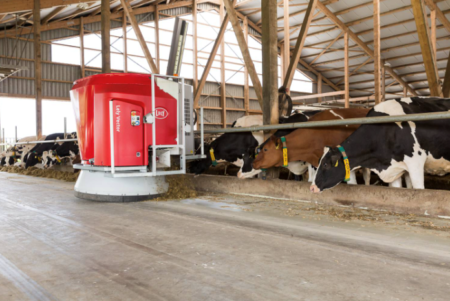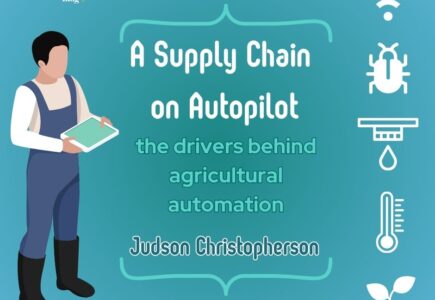Help Wanted
Recent advancements in artificial intelligence have spawned much concern surrounding the stability of labour demand as robots begin to replace human jobs. Simultaneously, agriculture has been plagued by a labour shortage across all levels of the supply chain, with employment numbers unable to recover since 2018. In 2018, the Canadian agriculture industry had over 60,000 vacant positions, making the 5.4% vacancy rate the highest among Canadian economic sectors. The negative implications for the entire agri-food chain, from input suppliers to end consumers, are numerous due to the shortfall in labour. In fact, the Canadian Federation of Agriculture states the labour shortcomings in Canadian agriculture resulted in $3 billion in lost sales for 2020.
Existing labour shortages are projected to grow into the future, with a 123,000-person shortage expected by 2030. The negative implications spread far beyond lost sales, with inefficiencies in supply chains leading to wasted food across the globe. This serves to drive up the cost of food and will have the greatest impact on the poorest in society. Solutions are needed, and labour-saving technology in agriculture production is a great place to begin.
Covid-19 – Exposing Fragility
At the production level, numerous farmers have felt the negative effects of a lack of labour availability in the sector. This shortage is noted to affect multiple facets of the agricultural supply chain here in Canada; however, it most notably affects farmers producing labour-intensive goods. This was exacerbated by the COVID-19 pandemic travel restrictions imposed by the government when producers with high labour requirements were unable to source foreign workers. The result was thousands of hectares of unharvested fruits and vegetables across the country tilled into the soil to provide fertilizer for next year’s crop. Though not a complete waste, the lost economic value of using food as fertilizer is significant, hence the estimated $3 billion in losses in 2020. It is argued that rising food prices will have the greatest impact on lower-income households (McCalla 2009), adding a sense of urgency to the issue as inflation continues to drive grocery prices higher. This Black Swan event exposes the fragility of agri-food supply chains, highlighting the lack of farm labourers within Canada’s borders.
Extensive Automation
In extensive systems, such as livestock or grain and oilseed production, the labour shortage is prominent as well. The average age of farmers grew to 56 years according to the 2021 census of agriculture, indicating that up to 40% of farmers will be retiring in the next ten years. Compounding the issue, Canada is seeing declines in both the number of farmers of all age classes and the number of young farms. In fact, the number of farmers aged 15-34 declined at twice the rate of all other age groups in the 25 year period from 1991 to 2016, underscoring a lack of interest in agriculture from the generation that is currently entering the workforce. In an industry that was characterized as having a high risk of burnout prior to the pandemic, a growing labour shortage poses a risk to the health and well-being of farmers and ranchers across the nation.
In response to these phenomena, automation is becoming a focal point of the leading machinery manufacturers around the globe. Well-known manufacturer John Deere has notably rolled out their autonomous technology for rigorous testing in North American markets (Figure 1). The innovative technology is a first for the industry, turning row-crop tractors into self-driving machines with a simple swipe on a phone screen. Obviously, John Deere expects that autonomy will characterize the agricultural industry moving forward as labour scarcity increases and the cost of such technologies falls below that of human capital. Subsequently, farmers will spend less time operating machinery and more time managing their businesses, recharging, and improving their local rural communities.

Not all pundits see automation in primary production agriculture as a beneficial move: an Agricultural Producers Association of Saskatchewan (APAS) representative highlighted concerns surrounding the growing concentration of agriculture at the production level. As automation becomes mainstream, the opportunity for the largest operators to expand their land base and the disparity between small and large farms will grow, as this technology is only accessible to those with enough acres to justify the high cost. Therefore, concerns arise about the loss of rural communities and an increasing concentration of power in food production systems as automation becomes mainstream.
Intensive Automation – Robotics in the Dairy Sector
Dairy production is one industry within the production agriculture space that has pushed the automation technological frontier far faster than its extensive counterparts. The extremely high labour requirements involved in maintaining a herd of dairy cows have moved the industry towards innovations such as robotic milking, semi-autonomous feeding, and automated health and performance tracking devices. The Rayner Dairy Research and Teaching Facility at the University of Saskatchewan provides a view into the state of automation in the sector. The Robot Voluntary Milking System used in the barn is comprised of 52 stalls. As the name suggests, cattle freely enter this system where their tracking collars are scanned to identify the animal and record performance details. Additionally, these systems are capable of identifying sickness and locating every cow in the barn, two arduous tasks that previously performed by human operators.
While the output of milk is fundamental to dairy automation, the feeding side has seen numerous automation innovations in recent years. The Lely Cosmix tracks the performance of individual animals, considering numerous metrics to determine the proper allocation of supplemental feed for each animal to optimize milking performance. Bottle-feeding is commonplace in the dairy sector and the Lely Calm limits the high labour requirements of manually feeding calves by automating the process. Most impressively, the Lely Vector is an automated, self-propelled and self-loading feed mixing and delivery device pictured in Figure 2. Dairy farmers place feed sources in the ‘feed kitchen’ where an automated crane loads the Vector with pre-specified ingredients to build an optimal total mixed ration (TMR).

The TMR is then distributed evenly on the bunks for the cattle. In typical systems, this feed would be pushed outwards as the cattle consume the ration, placing it out of reach and requiring that the feed be forked, shovelled, or otherwise pushed up to ensure the cattle have consistent feed access. The final innovation from Lely, the Juno, again automates this segment of the dairy barn by pushing feed frequently and around the clock to increase cattle feed intake and performance. This level of automation far exceeds that of grain and oilseed production, cow-calf production, feedlots, and even swine in many instances. The dairy sector appears to be rapidly pushing the technological frontier, enabling the sector to improve efficiency and effectiveness in a space that was formerly labour intensive.
Meat Processing – At the Forefront of Automation
Meat processing facilities are cold, damp, and often unappealing places to work. With temperatures necessarily being kept at or below 12ºC in processing rooms, physically demanding conditions, and repetitive workplace tasks, the industry is having great difficulty attracting and retaining an adequate workforce. The result is a staggering labour shortage, with job vacancy rates at 12.4% in 2019. The COVID-19 pandemic has only exacerbated this issue, as economic conditions have generated sub-five-percent unemployment rates across much of the prairies.
Meat processing has been quick to adapt to changing labour markets, with automation at the forefront of the transition. However, the demand for robotic butchering, loading, and processing equipment is far outpacing the supply. Complicating matters further, a lack of uniformity in beef carcasses limits the ability for robotic intervention in many segments of beef processing. In supply chains with greater uniformity, such as pork and poultry, robotic involvement in supply chains has been found to greatly improve efficiency and meat quality. Despite valid concerns of automation replacing jobs occupied by humans, the general manager of Harvest Meats in Yorkton believes that meat packing robots cannot replace many of the most complicated tasks on the plant floor; however, these advancements are required to overcome human resources shortfalls.
Concluding Remarks
A great deal of concern has been raised about the 20-million jobs that will be replaced by robots worldwide by 2030. It appears that in some industries, such as meat processing and packing, these advancements are required to overcome a lack of human resources, especially in rural areas. Increased profitability, corporate greed and efficiency improvements are oft-cited as the drivers of automation throughout our supply chains however, these may be side-effects of a dwindling labour force decreasingly interested in agri-food supply chains.
Additional Resources
McCalla, Alex. 2009. “World Food Prices: Causes and Consequences.” Canadian Journal of Agricultural Economics 57: 23–34.


